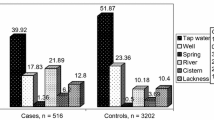Abstract
Objective: To reveal the relationship between the restriction of esophagus and the esophageal carcinogenesis. Methods: Male Wistar rats weighing 200±20g (N=50) observed as experimental animals. Using carcinogen N-ethyl-N-butyl-nitrosamine (EBN), or N-nitrosomethyl-N-propylamine (MPN), esophageal carcinogenesis was induced. In some rats, a cotton node was detained in the thoracic segment of the esophageal lumen to make artificial restriction. The rats were divided into 6 groups. Group EC or MC were those treated with the artificial restriction and EBN, or MPN. Group E, M or C included those treated only with EBN, MPN, or cotton node. Group U was untreated control. The rats were sacrificed, and the esophagus from the 6 groups of rats were compared. Results: On naked eye examination, the esophageal lesion was the most in EC group, followed by MC group. About 70% of the lesions were within 3mm from the thread node. The E or M group only had a few lesions. There was no observable lesion in the C and U groups. Histological examination found that the hyperplasia, hyperkeratosis, papilloma, and dysplasia were significantly more in EC and MC groups than E and M groups. Severe dysplasia and carcinomain situ were only noticed in the EC and MC groups. Conclusion: It is suggested that the artificial restriction promotes the esophageal carcinogenesis. The effect is related with increased contact with carcinogen and injury at the area of the restriction.
Similar content being viewed by others
References
Li JY, Liu BQ, Li GY, et al. (eds). Atlas of cancer mortality in the People’s Republic of China. Shanghai: China Map Press. 1979.
Yang PC, Davis S. Incidence of cancer of the esophagus in the US by histologic type. Cancer 1988; 61: 612.
Miura K, Suzuki K, Tokino T, et al. Detailed deletion mapping in squamous cell carcinomas of the esophagus. Narrows a region containing a putative tumor suppressor gene to about 200 kilobases on distal chromosome 9q. Cancer Res 1996; 56: 1629.
Lu JP, Xian MS, Hayashi K. Morphologic features of esophageal squamous cell carcinoma of young adults in North China. Cancer 1994; 74: 573.
Appelquist P, Salmo M. Lye corrosion carcinoma of the esophagus. Cancer 1980; 45: 2655.
Sons HU, Borchard F, Muller-Jah K, et al. Accelerated tumor induction by distal esophageal constriction in the rat under the influence of n-ethyl-n-butyl-nitrosamine. Cancer 1985; 56: 2617.
Druckrey H. Organospecific carcinogenesis in the digestive tract. In: Nakahara W, Takayama S and Sugimura T (eds). Tropics in chemical carcinogenesis. Baltimore University Park Press 1989; 73.
Sons HU, Borchard F. Esophageal cancer. Autopsy findings in 171 cases. Arch Pathol Lab Med 1984; 108: 983.
Ghadirian P. Thermal irritation and esophageal cancer in Northern Iran. Cancer 1987; 60: 1909.
Author information
Authors and Affiliations
Additional information
This work was supported by Grants for medical research from the Education Committee of China, Japan-China Medical Association, the Japan Society for the Promotion of Science, and Japan-China Peace and Friendship Association.
Rights and permissions
About this article
Cite this article
Lu, J., Hayashi, K. Site specific cancer induction by intra -esophageal cotton node retention and carcinogen laden drinking water. Chinese Journal of Cancer Research 10, 112–115 (1998). https://doi.org/10.1007/BF02954019
Accepted:
Issue Date:
DOI: https://doi.org/10.1007/BF02954019




